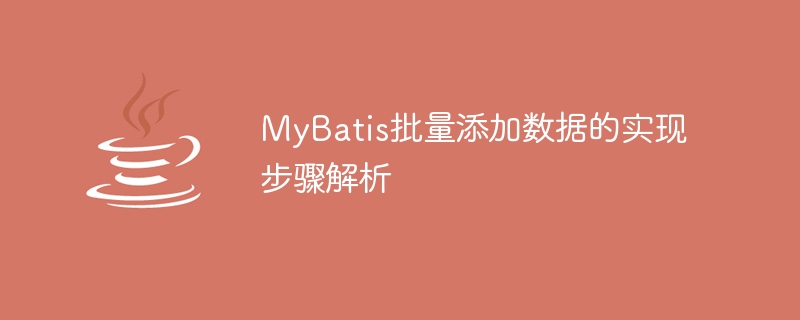分析MyBatis實現批量資料插入的步驟
- WBOYWBOYWBOYWBOYWBOYWBOYWBOYWBOYWBOYWBOYWBOYWBOYWB原創
- 2024-02-23 20:15:271302瀏覽

MyBatis是一款廣泛應用於Java專案中的持久層框架,它的強大之處在於可以透過簡單的映射檔案實現對資料庫的操作,並提供了豐富的功能來簡化開發者的工作。在實際專案中,經常會遇到需要批量添加資料的場景,本文將詳細介紹如何使用MyBatis實現批量添加資料的步驟,並附上具體的程式碼範例。
1. 建立資料庫表
首先,我們需要建立一張資料庫表來儲存將要新增的資料。以學生表為例,表格結構可能如下所示:
CREATE TABLE student (
id INT PRIMARY KEY AUTO_INCREMENT,
name VARCHAR(50),
age INT
);2. 定義實體類別
接下來,我們需要定義一個與資料庫表對應的實體類別。在這個範例中,我們可以定義一個名為Student的實體類,包含id、name和age三個屬性,並提供對應的Getter和Setter方法。
public class Student {
private int id;
private String name;
private int age;
// Getter和Setter方法
}3. 寫Mapper介面與映射檔
我們需要寫一個Mapper接口,定義新增資料的方法。在這個例子中,我們可以定義一個名為StudentMapper的接口,包含一個批次新增資料的方法。
public interface StudentMapper {
void batchInsert(List<Student> students);
}然後,在對應的映射檔案StudentMapper.xml中,編寫SQL語句來實現批次新增資料的操作。需要注意的是,需要使用MyBatis的foreach標籤來遍歷傳入的資料清單。
<insert id="batchInsert" parameterType="java.util.List">
INSERT INTO student (name, age) VALUES
<foreach collection="list" item="student" separator=",">
(#{student.name}, #{student.age})
</foreach>
</insert>4. 編寫Service層
在Service層中呼叫Mapper介面中定義的批次新增資料的方法,傳入需要新增的資料清單。
@Service
public class StudentService {
@Autowired
private StudentMapper studentMapper;
public void batchAdd(List<Student> students) {
studentMapper.batchInsert(students);
}
}5. 呼叫Service層方法
最後,在需要新增資料的地方呼叫Service層的方法,傳入需要新增的資料清單即可完成批次新增資料的操作。
public class Main {
public static void main(String[] args) {
List<Student> students = new ArrayList<>();
students.add(new Student("Alice", 20));
students.add(new Student("Bob", 21));
StudentService studentService = new StudentService();
studentService.batchAdd(students);
}
}透過上述步驟,我們成功實作了使用MyBatis批次新增資料的操作。在實際專案中,可以根據業務需求和表格結構的不同,靈活調整上述程式碼以適應具體情況。 MyBatis的foreach標籤和大量新增功能為我們提供了一種高效、簡潔的資料庫操作方法,能夠大幅提升開發效率。
以上是分析MyBatis實現批量資料插入的步驟的詳細內容。更多資訊請關注PHP中文網其他相關文章!
陳述:
本文內容由網友自願投稿,版權歸原作者所有。本站不承擔相應的法律責任。如發現涉嫌抄襲或侵權的內容,請聯絡admin@php.cn

